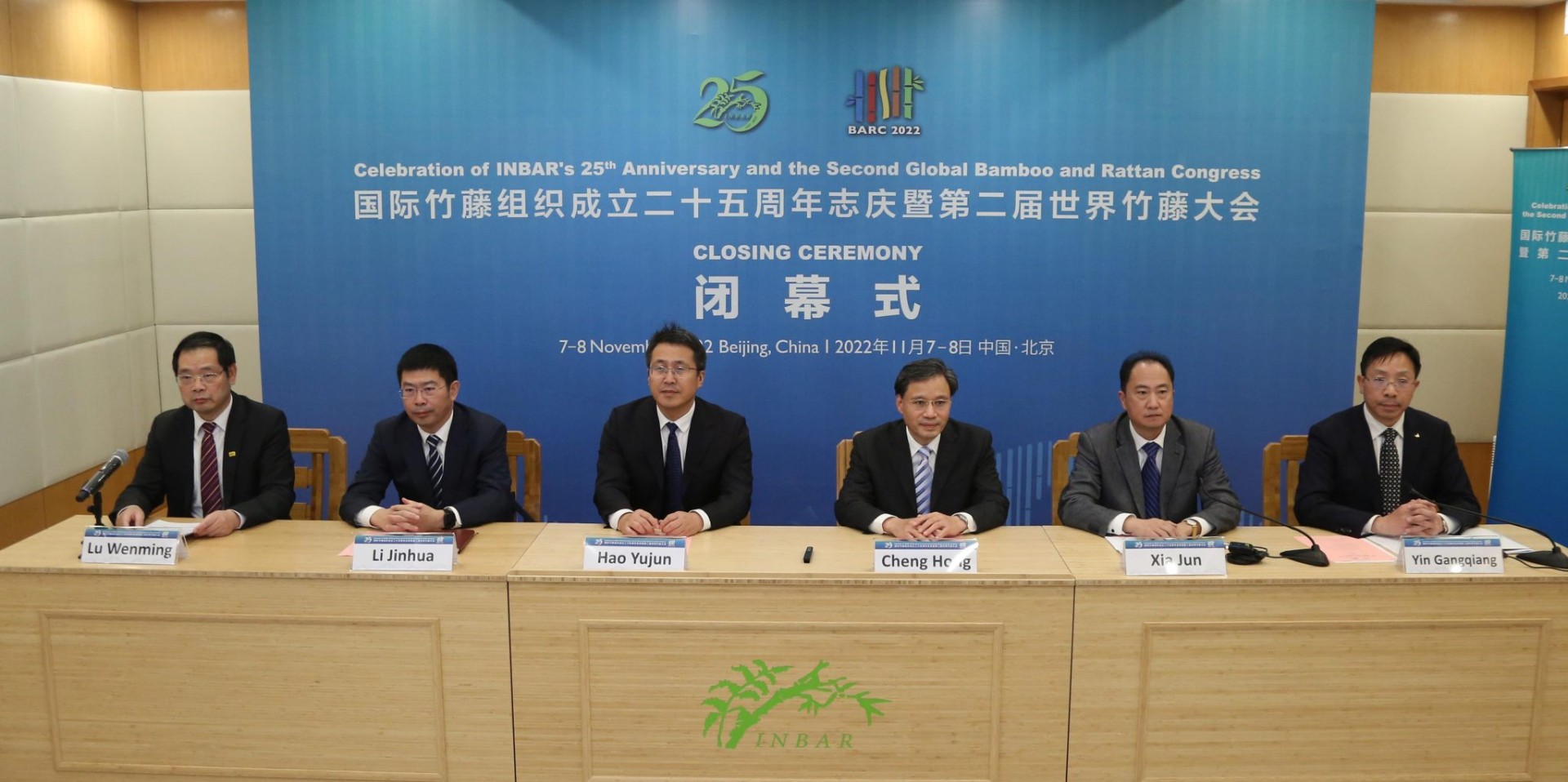BARC 2022 concluded with robust discussions across parallel sessions and inspirational messages from high-level leaders.
On 8 November 2022, over 30 parallel sessions were launched as part of the Second Bamboo and Rattan Congress (BARC 2022) convened in Beijing.
Topics for the sessions were arranged across four thematic areas: The Road to Carbon Neutrality; Green Industry and Economic Recovery; Innovative Materials and Market Development; and Working Together for Inclusive and Green Development.
Meetings were held nonstop throughout the day via hybrid format. Participants and speakers connected from around the world to make presentations at sessions with titles such as “Facilitating International Trade of Bamboo and Rattan Commodities,” “Equipment R&D and Intelligent Manufacture,” “Bamboo: A Resource for Generating Partnerships and Addressing Climate Change” and more.
Session 2.2 “International Seminar on Nature Based Solutions for Rural Revitalization” was co-organized by INBAR, Xishuangbanna Tropical Botanical Garden, Chinese Academy of Sciences (CAS-XTBG), Southeast Asia Biodiversity Research Institute, Chinese Academy of Sciences (CAS-SABR), International Center for Integrated Mountain Development (ICIMOD), Center for Mountain Futures (CMF) and the Southwestern University of Finance and Economics, focusing on the theme of Green Industry and Economic Recovery.

Prof. Xu Jianchu, Director of the Centre for Mountain Futures, spoke on the importance of agroforestry in mountain regions.
Rural revitalization seeks to improve employment opportunities and strengthen livelihoods in smaller towns and cities, forging links between rural and urban economies. Accordingly, this session featured scientists and professionals in fields from biodiversity conservation, ecology, environmental protection, rural development, regional cooperation and development. Also present were representatives from green finance, trade and carbon neutrality organizations, local government officials, planning, investment, and aid agencies, entrepreneurs, NGOs and more. The session sought to deepen our understanding of overall biodiversity patterns around the world, showcase best practices for humankind-nature interactions and encourage capacity building as well as raise public awareness. Ultimately, the main goal of the session was to cultivate a new multi-stakeholder approach to biodiversity conservation and sustainable development. Speakers reached broad consensus regarding the need for a collaborative approach not only between stakeholders but also between nature and humans, singling out nature-based solutions as pivotal “keys” for unlocking the type of transformative mechanisms our world needs to spur a green transition.
Session 4.6 “International Seminar on Bamboo and Rattan Clusters for Regional Development and Green Transition” was organized by the National Forestry and Grassland Innovation Alliance of Bamboo and Rattan Industry (China), China Bamboo and Rattan Brand Cluster, International Centre for Bamboo and Rattan (ICBR), INBAR and the Southwestern University of Finance and Economics, focusing on the theme of Working Together for Inclusive and Green Development.
Li Lan, Director of Industrial Development of ICBR, introduced China’s bamboo sector and the development of collaborative bamboo platforms.
“Cluster development” is a type of economic development that has gained attention in the last few decades. It generally features an umbrella initiative that unites different industry chains and interrelated businesses in a collaborative endeavor. In particular, “cluster development” is noteworthy for stimulating urban and rural growth at the same time. But how to best address bamboo and rattan clusters to accelerate the green transition? This question was targeted by the session, with emphasis on undertaking coordinated actions and strategic partnerships across the complete supply chain in bamboo and rattan sectors. In attendance were stakeholders from bamboo- and rattan-producing countries, green finance, trade and carbon neutrality organizations and more. Their objective was to bridge gaps across technology, personnel, market and trade, promoting dialogue between disparate actors. Potential solutions were offered by speakers for how to best arrange industries, markets and trade cooperation in an equitable manner that stimulates economic growth for regional sustainable development.
At the day’s end, participants and speakers alike were buzzing with energy. Energetic discussions had led to concrete outcomes and recommendations, which generated a deep sense of trust and collaboration between the diverse stakeholders.
This sense of excitement had grown throughout the day. Finally, it reached a crescendo at the convening of the Closing Ceremony.
First, Lu Wenming, Deputy Director of INBAR, gave a speech announcing the formal end of BARC 2022. A dynamic video was next played of the congress proceedings, allowing those who had been unable to attend in-person feel the excitement of event.
Next, Xia Jun, Deputy Director of the Department of International Cooperation of the National Forestry and Grassland Administration of China (NFGA), highlighted the role bamboo and rattan play in countries around the world as nature-based solutions capable of simultaneously addressing a plethora of thorny issues, from landscape restoration to rural livelihood improvement.
Finally, Yin Gangqiang, Deputy Director of the International Centre for Bamboo and Rattan (ICBR), spoke highly of INBAR’s work over the last 25 years since its establishment, reaffirming the work of the Government of China in supporting INBAR to facilitate its mission of global sustainable development using bamboo and rattan.
